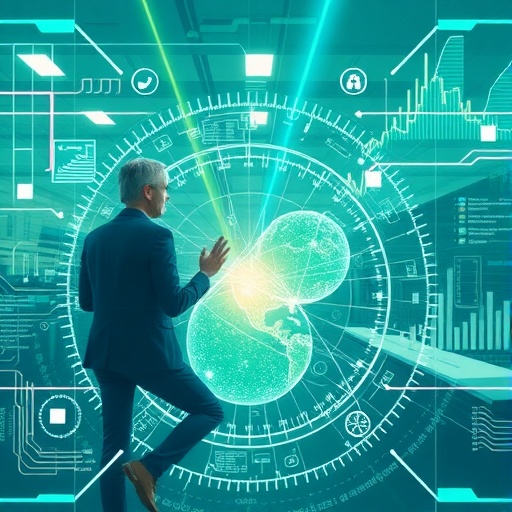In the face of escalating environmental challenges, such as climate change, resource depletion, and pollution, businesses worldwide are rapidly shifting towards sustainable practices. The circular economy emerges as a critical approach wherein the traditional linear models of production and consumption are being reimagined. The recent study by Yang and Zailani, published in “Discover Sustainability,” sheds light on the integral role of digital technologies in surmounting the hurdles that organizations encounter when attempting to implement circular economy business models. As researchers map the landscape of these advancing technologies, they unveil transformative potentials that could redefine the essence of sustainability in corporate strategies.
Digital transformation is now vital for modern businesses seeking a competitive edge. Utilize profound data analytics, Internet of Things (IoT), and artificial intelligence (AI) can harness large data sets to drive efficiencies and reduce waste. These technologies create a synergistic relationship between physical resources and digital capabilities, enabling smarter resource management. For instance, AI algorithms can predict consumption patterns, leading to reduced production of surplus products and, consequently, less waste. This highlights how digital solutions not only support the aims of sustainability but also enhance profitability—a dual benefit that savvy businesses cannot afford to overlook.
The study focuses on bibliometric mapping, a powerful tool that offers a visual representation of the existing body of knowledge in the digital technologies domain relevant to the circular economy. By analyzing publications, citations, and research trends, Yang and Zailani provide an insightful overview of the interplay between technology and sustainable business practices. This method allows stakeholders to identify key areas where further research might be needed, fostering collaboration and innovation.
When we consider the circular economy framework, it becomes evident that the concept relies heavily on systemic thinking and interconnections among various stakeholders. Digital technologies act as facilitators that break down traditional silos, enhancing communication and cooperation within supply chains. For example, blockchain technology ensures transparency and traceability of materials throughout their lifecycle, ensuring that businesses can confidently recycle or repurpose their products. In this context, technology becomes not just a tool but a crucial partner in achieving a circular economy.
One crucial barrier to implementing circular economy models is the lack of real-time data and feedback loops that allow businesses to make informed decisions. The authors underline that digital technologies can provide timely insights that help navigate the complexity of resource management. By integrating real-time tracking of materials through IoT devices, companies can adjust their operations instantly based on supply and demand fluctuations, thereby optimizing for minimal waste and maximal reuse.
Equally important is the role of educational initiatives that accompany the technological shift. Knowledge sharing among businesses and industries leads to a better understanding of circular practices. Digital platforms facilitate training and awareness programs that help stakeholders grasp the underlying principles of the circular economy. As organizations invest in training their workforce, they empower them to harness digital tools effectively, promoting a culture of sustainability that permeates every level of the organization.
Still, the research emphasizes that while technology offers promising solutions, challenges remain. Many businesses, especially SMEs, face financial and resource constraints that hinder their ability to adopt advanced technologies. Yang and Zailani contend that collaborations among academia, industry stakeholders, and governments are essential to democratize access to digital solutions. Initiatives such as grants, subsidies, and knowledge-sharing platforms can bridge the gap, enabling a broader array of companies to engage with circular economy principles effectively.
The implications of implementing digital technologies for the circular economy are immense and multifaceted. The integration of these systems can lead to substantial cost savings while concurrently reducing environmental footprints. The effective management of resources not only enhances operational efficiency but also positions businesses as leaders in sustainability efforts. As traditional business practices become outdated, those organizations that proactively adopt these digital solutions will likely enjoy a significant competitive advantage.
From consumer behavior to regulatory pressures, the forces shaping modern businesses are rapidly evolving. The study highlights that the transition to a circular economy is not merely a trend but a fundamental shift in how businesses operate. Companies must adapt to these changes swiftly or risk obsolescence. This calls for agility, foresight, and a commitment to continuous improvement—qualities that digital technologies naturally facilitate.
Yang and Zailani further emphasize that fostering a mindset of openness and adaptability is crucial for businesses navigating this transition. An ingrained culture of sustainability, supported by digital innovation, allows companies to respond effectively to changes in consumer expectations, market dynamics, and regulatory demands. By committing to a circular economy, organizations can not only mitigate risks but also seize new market opportunities that align with emerging sustainability trends.
In conclusion, the exploration of the role of digital technologies in overcoming barriers to the adoption of circular economy business models promises transformative potential for industries worldwide. As highlighted in the study by Yang and Zailani, businesses that embrace these digital solutions are better equipped to navigate complexity and drive positive change. By fostering collaboration, investing in technology, and cultivating a culture of sustainability, organizations can lead the way toward a more sustainable future, benefiting both their bottom line and the planet at large.
This research serves as a call to action for businesses worldwide. By leveraging the insights gained from bibliometric mapping and prioritizing the integration of digital technologies, organizations can pave the path to sustainability and meet the pressing challenges of our time with innovative, effective solutions.
Subject of Research: Role of digital technologies in overcoming barriers to circular economy business models.
Article Title: Bibliometric mapping of digital technologies for overcoming barriers to circular economy business model implementation.
Article References:
Yang, X., Zailani, S. Bibliometric mapping of digital technologies for overcoming barriers to circular economy business model implementation.Discov Sustain 6, 1175 (2025). https://doi.org/10.1007/s43621-025-01981-5
Image Credits: AI Generated
DOI: 10.1007/s43621-025-01981-5
Keywords: Circular Economy, Digital Technologies, Bibliometric Mapping, Sustainability, Resource Management, Blockchain, Internet of Things, Artificial Intelligence, Business Models.




